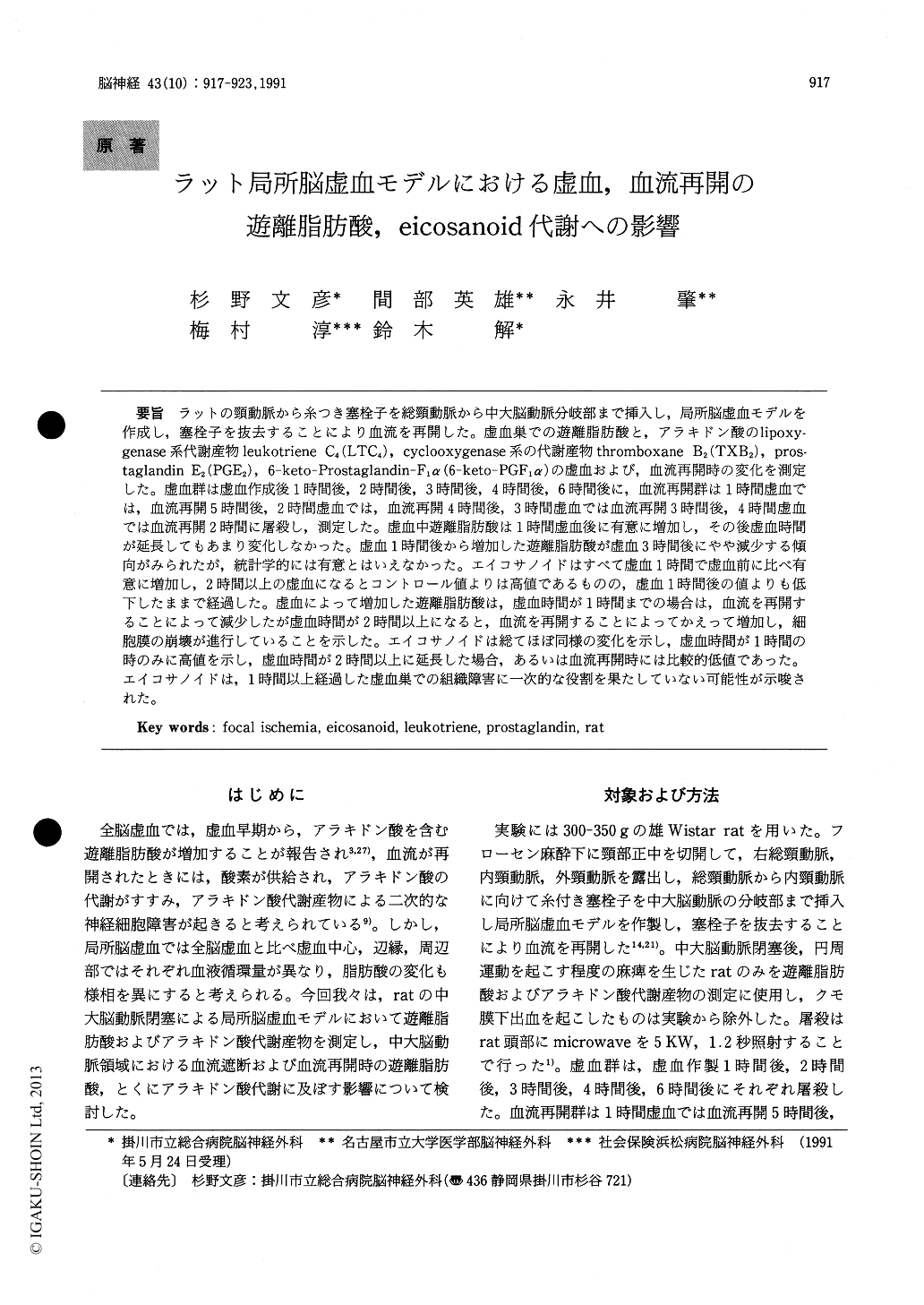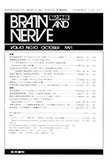Japanese
English
- 有料閲覧
- Abstract 文献概要
- 1ページ目 Look Inside
ラットの頸動脈から糸つき塞栓子を総頸動脈から中大脳動脈分岐部まで挿入し,局所脳虚血モデルを作成し,塞栓子を抜去することにより血流を再開した。虚血巣での遊離脂肪酸と,アラキドン酸のlipoxy—genase系代謝産物leukotriene C4(LTC4),cyclooxygenase系の代謝産物thromboxane B2(TXB2),pros—taglandin E2(PGE2),6—keto-Prostaglandin-F1α(6—keto-PGF1α)の虚血および,血流再開時の変化を測定した。虚血群は虚血作成後1時間後,2時間後,3時間後,4時間後,6時間後に,血流再開群は1時間虚血では,血流再開5時間後,2時間虚血では,血流再開4時間後,3時間虚血では血流再開3時間後,4時間虚血では血流再開2時間に屠殺し,測定した。虚血中遊離脂肪酸は1時間虚血後に有意に増加し,その後虚血時間が延長してもあまり変化しなかった。虚血1時間後から増加した遊離脂肪酸が虚血3時間後にやや減少する傾向がみられたが,統計学的には有意とはいえなかった。エイコサノイドはすべて虚血1時間で虚血前に比べ有意に増加し,2時間以上の虚血になるとコントロール値よりは高値であるものの,虚血1時間後の値よりも低下したままで経過した。虚血によって増加した遊離脂肪酸は,虚血時間が1時間までの場合は,血流を再開することによって減少したが虚血時間が2時間以上になると,血流を再開することによってかえって増加し,細胞膜の崩壊が進行していることを示した。エイコサノイドは総てほぼ同様の変化を示し,虚血時間が1時間の時のみに高値を示し,虚血時間が2時間以上に延長した場合,あるいは血流再開時には比較的低値であった。エイコサノイドは,1時間以上経過した虚血巣での組織障害に一次的な役割を果たしていない可能性が示唆された。
Focal brain ischemia was induced in rats by inser-ting a silicone rubber cylinder attached to a nylon surgical thread from the common carotid artery into the middle cerebral artery bifurcation. Reper-fusion was achieved by removing the cylinder. In the ischemic area, free fatty acids were measured. Arachidonic acid lipoxygenase metabolites : leu-kotriene C4 (LTC4, and cyclooxygenase metabo-lites: thromboxane B2 (TXB2) prostaglandin E, (PGE2) and 6-keto-prostaglandin- F1α(6-keto- PGF1α) were measured during ischemia and after reperfusion. There were five ischemia groups. The rats in these groups were killed 1, 2, 3, 4 or 6 hours after occlusion. In the reperfusion group, rats exposed to 1, 2, 3 and 4 hours of ischemia were killed 5, 4, 3 and 2 hours after reperfusion, respectively.
The free fatty acids, which had increased due to occlusion, decreased after reperfusion from 1 hour of ischemia. With 2 or more hours of ischemia, however, the free fatty acids increased after reper-fusion, indicating cell membrane destruction.
Eicosanoids showed almost the same changes in all groups. The eicosanoid level was high only after 1 hour of ischemia and it stayed low if the ischemia time exceeded 2 hours and after reperfusion. There-fore, we suggested that eicosanoids are not a main cause of tissue damage in the ischemic area after 2 or more hours of ischemia.

Copyright © 1991, Igaku-Shoin Ltd. All rights reserved.


